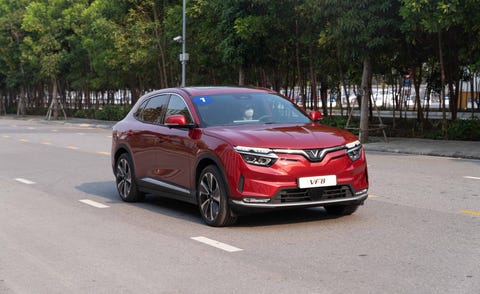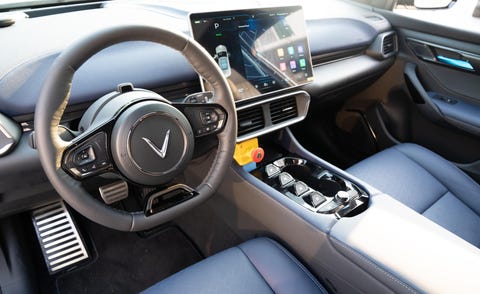VinFast Is Going All-Electric, and Worldwide, at Full Speed

Vinfast is a Vietnamese startup automaker that recently details plans to sell, and eventually build, its vehicles in the United States.The Vinfast offerings for our market are the VF8 and the VF9, both EV crossovers.The automaker’s facility in its home country was coastal swampland in 2017 but is now a modern production facility.
The “FAST” in the VinFast name is an acronym in Vietnamese, representing the stated goals of the company, but it’s not lost on us, or the company’s founders, that in English, it means something done quickly. The new automotive brand was announced in the fall of 2017, and barely a year later VinFast had three gasoline-powered cars available in Vietnam, and an electric scooter factory. By the summer of 2019 the company had completed an 827-acre automotive facility in Hai Phong and was delivering its first cars. As its ICE cars were gaining traction in its home market, VinFast founder Pham Nhat Vuong announced in 2021 that the company would pivot to EVs. By the end of the year, it was selling electric scooters, electric buses, and the VF e34, a small electric SUV about the size of a Toyota C-HR, with promises of two larger models to come, the VF8 and the VF9. The mid-size 5-seat VF 8 and 7-seat VF9 will not only come to the U.S. market but be built here, in a new 2000-acre factory in North Carolina. The goal, said Vuong, is to make VinFast a recognizable name worldwide and, you guessed it, to do it fast.
Tung Pham Photo
How It’s Made
VinFast invited us to Vietnam to visit its factory in Hai Phong and to get a sense of the broad range of its parent company VinGroup, with businesses that include hotels, apartments, assembly plants, business parks, schools, and medical research. Everyone we spoke with at VinFast, when asked what the driving force was behind the company’s quick pace and ambitious goals, immediately responded with a story about the chairman, Pham Nhat Vuong.
Pham has a track record of success in unlikely markets. He grew up in Hanoi, where his mother ran a tea shop. He studied in Moscow, then moved to Ukraine where he started a noodle restaurant that became popular enough to spin off into an instant soup company, Technocom. Nestle purchased the brand, and Pham moved back to his homeland, where he began a chain of resorts and became Vietnam’s first billionaire. Personal success might be enough for some, but he wants to make Vietnam a player on the world stage.
“Vietnam is not known for being an industrial country,” Pham says. “It is not known for manufacturing, but we are developing.” He went on to say that he sees VinFast as a leader in the EV market in the future. “Maybe not in five years, but in 10? We want to be at the top.” Why such a quick timeline when other companies take decades to grow? “Life is short, I cannot be slow.”
On a tour of VinFast’s Hai Phong factory, we saw body stampings being made, frames being welded by some 1200 robots, and the assembly area where both engines and electric motors are installed. In the battery shop, individual cells purchased primarily from Samsung and LG are tested and assembled into packs for the e34, and soon for the VF8 and VF9. Motors are built in-house. The goal is to deliver two new models by the end of 2022 and to produce nearly 100,000 cars a year by 2026—big numbers, but big growth is not new to VinFast. The factory site was coastal swampland in 2017 and the yet plant was up and running in 21 months—too fast for Google maps to keep up. If you look it up, Google shows the entire VinFast campus as being in the ocean. We can report it’s on dry land.

Tung Pham Photo

The 2023 VF8
The Ford Bronco–sized VF8 is the smaller of the two VinFast models that will come to the US and is farther along in development than the three-row VF9. At the end of the factory tour, we were given the opportunity to briefly get behind the wheel of a few VF8 prototypes. As they were assembled from test mules for our visit, and each machine had development quirks obvious even on our two-block test drive. One had a jumpy accelerator, another laggy. One had its seat controls reversed, as we discovered when we went to slide it forward and smashed the knees of the guy in the back. Most of the promised driver’s aids, such as remote summon and self-parking, were non-functional. Again, these were prototypes. With 349 horsepower and 369 pound-feet of torque, the Eco model delivered adequate acceleration, and the 402-hp Plus trim with 457 pound-feet of torque was downright quick. There was only one turn on our drive, and we took it fast enough to dump the engineer’s notes into the passenger footwell, so apologies to him, but steering worked. The brakes stopped the car fine but were set at a minimal regen and couldn’t be changed despite a menu option for more energy recovery. Chief engineer Huy Chieu says that adjustable regeneration will be ready for production with “one-pedal” driving likely down the line. The AWD car—the only version we’ll get in the states—offers two battery pack options per trim level, with range estimates from 248 miles to 292.
External fit and finish was better than we’d expect for a prototype. Designed by Pininfarina, the exterior is standard SUV with some interesting details, like a long LED strip leading to a V in the nose, and bodywork that ducts air around the front wheels. Inside, there’s the somewhat radical decision to do away with instrumentation in front of the driver and instead rely solely on the large central screen and head-up display. Our sample car was finished in a gorgeous deep blue leather, but the materials are otherwise rather traditional. When asked about the choice of faux carbon and gloss plastic trim versus more experimental materials, or materials that reflect the automaker’s culture—as we’re seeing with Volvo and Genesis—David Lyons, director of design, looked mildly exasperated. “What, like bamboo? People here would see that and say, ‘It’s a weed!’” Even with too much plastic, the interior is comfortable and brightly lit by a large sunroof. Cargo room seems on par with similarly sized vehicles, and there’s a small frunk in addition to the rear hatch.
Batteries Not Included
Prototype pains aside, the VF8 is attractive and well-equipped, but VinFast’s big selling point is smart car technology. It plans to offer “Smart Services” such as a virtual assistant, streaming video, virtual assistant, pet mode, camp mode, car wash mode, and connections between the car and a smart home.
There was a time when this would have been impressive in an electric EV starting at $40,000, but VinFast may lose customers to its confusing battery subscription program, which requires a lease on the battery not included in the purchase price.
VinFast says it will offer two variants of the subscription, Flexible and Fixed. Flexible feels like an old-fashioned cell phone plan, with a small monthly fee ($35 for VF8 and $44 for VF9) and a mileage limit of 310 miles per month, and then $0.11–0.15 per mile after that. The Fixed plan is more like unlimited data, at $110 per month for the VF8 and $160 for the VF9 with no mileage caps. VinFast says the subscription addresses customer concerns about battery life because a leased battery will effectively be always under warranty, but we think it’s more likely to complicate the purchase of an EV than ease it. It’s possible VinFast is having second thoughts as well, as the company followed its first announcement about the plan with the addendum that customers will have a choice of battery subscription or purchase by 2024. And part of being fast, after all, is adapting quickly.
This content is created and maintained by a third party, and imported onto this page to help users provide their email addresses. You may be able to find more information about this and similar content at piano.io





